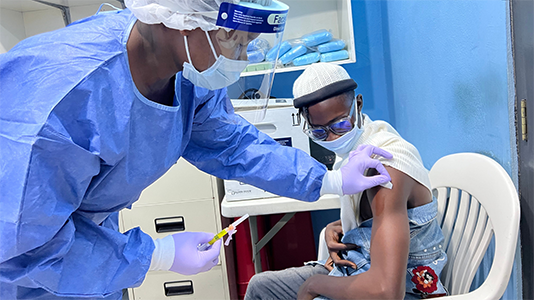Deploying a safe and effective Lassa vaccine across 15 countries of continental West Africa could save nearly 3,300 lives over 10 years and avert up to $128m in societal costs, new research by modelling experts shows.
The peer-reviewed study published in August, on Nature Medicine, is titled, ‘Health and economic impacts of Lassa vaccination campaigns in West Africa.’
Being vaccinated against Lassa Fever – a viral disease spread by rodents and infected food—would prevent millions of people from falling sick with the disease and facing prohibitive treatment costs that could otherwise push them below the poverty line, according to findings of the study by the Universities of Oxford and Liverpool and the Liverpool School of Tropical Medicine.
The study led by David Smith of the Nuffield Department of Population Health, Health Economics Research Centre, University of Oxford, Oxford, UK, noted that a vaccine effective against infection in addition to disease was found to have moderately increased impact.
This study demonstrates the urgent need for a vaccine to protect people from this debilitating and sometimes deadly disease which we believe affects many more than those who are reported, due to limited access to diagnostics and healthcare.
The research team also assessed the impact of deploying a vaccine against a new Lassa-like virus with pandemic potential – a hypothetical disease they called Lassa X – within 100 days of its emergence.
This was to model the potential impact of the 100 Days Mission in the event of a future human outbreak of a Lassa-like viral disease.
The results showed that around 5,500 lives could be saved and 33,000 hospitalisations avoided over the course of a two-year outbreak if safe and 70 percent effective Lassa X vaccines were given to 40 percent of people per year starting within 100 days.
The 100 Days Mission is a global goal, spearheaded by CEPI, to deliver a vaccine against Disease X in 100 days which could stop an outbreak of a new disease before it spirals out of control into a pandemic.
Lassa fever has been identified by the World Health Organisation as one of the pathogens most likely to cause future severe outbreaks.
Climate change and other environmental and demographic factors are threatening to put as many as 700 million people at risk of developing Lassa fever in the future, underscoring the pandemic potential of the virus and the urgent need for effective vaccines.
Lassa fever symptoms include fever, headache, muscle pain, and vomiting. In severe cases, victims suffer facial swelling and bleeding from the mouth, nose, vagina or gastrointestinal tract. About a quarter of those who survive severe Lassa fever infection develop deafness.
This new study estimates that there are on average 23,700 hospitalisations and 3,900 deaths per year due to Lassa fever in West Africa. But Lassa’s true disease burden could be much higher than reported due to limited access to diagnostics and healthcare.
The modelling showed that the most effective vaccination strategy was a population-wide preventative campaign primarily targeting areas where the virus is endemic and that reactive vaccination programmes in response to local outbreaks averted just one-tenth of the health-economic burden when compared with population-wide preventative campaigns.
Smith said ‘To our knowledge, this is the first burden of disease study for Lassa fever as well as the first to project impacts of Lassa vaccination campaigns on population health and economies. One major potential benefit of present investment in Lassa vaccination development is increased readiness to rapidly develop and deploy vaccines against future Lassa variants with pandemic potential.’
The researchers concluded, “Our analysis suggests that vaccination campaigns targeting known Lassa fever hotspots will help to alleviate the large health-economic burden caused by this disease. However, expanding vaccination beyond WHO-classified ‘endemic’ districts will be necessary to prevent the large burden of disease estimated to occur in neighboring areas not currently classified as endemic.
“Improved surveillance is greatly needed to better characterise the epidemiology of Lassa fever across West Africa, helping to inform the design of vaccination campaigns that maximise population health by better targeting those at greatest risk of infection and severe outcomes.”
The Chief Executive Officer of Coalition for Epidemic Preparedness Innovations, Richard Hatchett said “Lassa fever is a serious public health problem in West Africa and is already threatened to spread to further regions as climate and environmental change increase epidemic risk”.
WHO remains committed to working with our Member States, CEPI, and all stakeholders to ensure that we fast-track the development of a vaccine and other tools we need to control the spread of Lassa fever and protect our communities. Time is now up for concrete actions.”
Head of Division – Preparedness and Response at the West African Health Organisation, Dr Virgil Lokossou said, “Lassa fever continues to pose a serious public health threat in West Africa, severely impacting our lives, health and economic systems. This modelling study highlights the burden of Lassa fever and its significant socioeconomic consequences, underscoring the urgent need to accelerate vaccine research and development as part of the regional preparedness and response efforts.
Joanne Turner, research associate at the University of Liverpool and joint first author, said ‘The Lassa vaccination campaigns included in our analysis were designed to reflect realistic assumptions about vaccine stockpile and administration, and as such included a constrained global vaccine stockpile (<20M doses annually) and limited allocation to districts not currently classified as endemic by WHO. Consequently, the impacts of our simulated Lassa vaccination campaigns were modest in countries other than Nigeria, Guinea, Liberia, and Sierra Leone. Yet the data underlying our model suggest that there is likely already a significant burden of Lassa fever outside these countries.’
Professor of Infectious Disease Epidemiology at the University of Oxford Big Data Institute Déirdre Hollingsworth said, ‘Lassa fever predominantly affects low-income populations in rural areas and is likely to be highly underreported due to poor health access in these areas. This analysis highlights the potential impact of a vaccine in these populations’.


